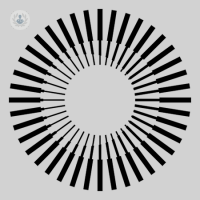What is the retina?
The retina is a thin layer of tissue on the back wall of the eye made up of different cells (retinal pigment epithelium, nerve cells and photoreceptor cells). The photoreceptor cells (cones and rods) react to light, and send electrical signals to the brain, which interprets these signals as vision.
The retina, along with the optic nerve, develops in the embryo as part of the brain tissue, making it part of the central nervous system. Being a nervous tissue, the retina doesn’t have the ability to regenerate itself.
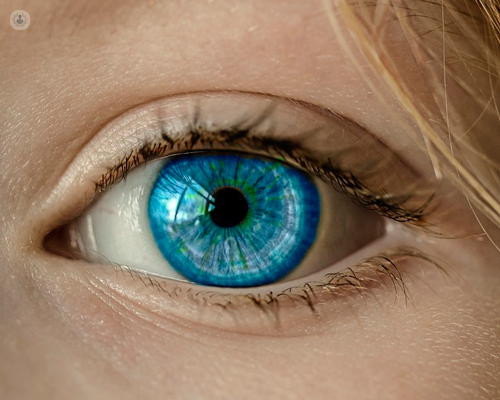
What does the retina do?
The retina is responsible for our vision. The photoreceptor cells (cones and rods) react to light entering the eye, releasing chemicals, which in turn trigger a nerve impulse, which is sent to the cerebral cortex via the optic nerve. The pattern of light hitting the photoreceptor cells triggers a unique set of electrical signals, which are interpreted by the brain as an image.
Rod cells function well in low light, providing us with our night vision. They contribute little to colour vision, which is why we find it difficult to distinguish colours in darkness. They tend to be concentrated around the edge of the retina and are also used for peripheral vision.
Cone cells, on the other hand, are less sensitive to light, making them of little use in low-light conditions. However, they are responsible for our colour vision. Most people have three kinds of cone cell. Each type is sensitive to a different visible wavelengths of light, giving us trichromatic vision. The mixture of signals sent by the different cone cells being stimulated to different degrees creates the mixture of colours we can perceive. Some people are born with only two types of cone cells, limiting the range of colours they can perceive, causing them to easily confuse colours that appear different to someone with all three types of cone cell.
What conditions can affect it?
Retinal conditions can affect your eyesight with different degrees of severity. They can be either acquired or inherited:
- Diabetic retinopathy – diabetes causes the capillaries that supply the retina to leak fluid into or under the retina, leading to swelling and distorted vision.
- Retinal tear – when the gel-like vitreous inside the eye shrinks it can tug at the retina, and sometimes this can cause a tear.
- Retinal detachment – a disorder in which the retina becomes loose and detaches from the tissue underneath. It is usually caused when fluid passes through a retinal tear.
- Retinitis pigmentosa – a degenerative disease of the retina
- Macular degeneration (AMD) – age-related deterioration of the macula – a small part of the retina with a high concentration of cone cells, responsible for central colour vision.
- Macular hole – a small defect in the macula, perhaps caused by trauma or traction between the retina and the vitreous.
- Macular oedema - swelling in the retina caused by a number of conditions. Macular oedema is very common in uveitis and is often a driver for treatment.
How can such conditions be treated?
The treatment will vary according to the specific condition. Some conditions can be treated with intravitreal injections; for others, the only option is surgery.
Which doctor should I see?
You should see a specialised ophthalmologist.
05-12-2017 12-12-2024Retina
Miss Rahila Zakir - Ophthalmology
Created on: 05-12-2017
Updated on: 12-12-2024
Edited by: Conor Lynch
What is the retina?
The retina is a thin layer of tissue on the back wall of the eye made up of different cells (retinal pigment epithelium, nerve cells and photoreceptor cells). The photoreceptor cells (cones and rods) react to light, and send electrical signals to the brain, which interprets these signals as vision.
The retina, along with the optic nerve, develops in the embryo as part of the brain tissue, making it part of the central nervous system. Being a nervous tissue, the retina doesn’t have the ability to regenerate itself.

What does the retina do?
The retina is responsible for our vision. The photoreceptor cells (cones and rods) react to light entering the eye, releasing chemicals, which in turn trigger a nerve impulse, which is sent to the cerebral cortex via the optic nerve. The pattern of light hitting the photoreceptor cells triggers a unique set of electrical signals, which are interpreted by the brain as an image.
Rod cells function well in low light, providing us with our night vision. They contribute little to colour vision, which is why we find it difficult to distinguish colours in darkness. They tend to be concentrated around the edge of the retina and are also used for peripheral vision.
Cone cells, on the other hand, are less sensitive to light, making them of little use in low-light conditions. However, they are responsible for our colour vision. Most people have three kinds of cone cell. Each type is sensitive to a different visible wavelengths of light, giving us trichromatic vision. The mixture of signals sent by the different cone cells being stimulated to different degrees creates the mixture of colours we can perceive. Some people are born with only two types of cone cells, limiting the range of colours they can perceive, causing them to easily confuse colours that appear different to someone with all three types of cone cell.
What conditions can affect it?
Retinal conditions can affect your eyesight with different degrees of severity. They can be either acquired or inherited:
- Diabetic retinopathy – diabetes causes the capillaries that supply the retina to leak fluid into or under the retina, leading to swelling and distorted vision.
- Retinal tear – when the gel-like vitreous inside the eye shrinks it can tug at the retina, and sometimes this can cause a tear.
- Retinal detachment – a disorder in which the retina becomes loose and detaches from the tissue underneath. It is usually caused when fluid passes through a retinal tear.
- Retinitis pigmentosa – a degenerative disease of the retina
- Macular degeneration (AMD) – age-related deterioration of the macula – a small part of the retina with a high concentration of cone cells, responsible for central colour vision.
- Macular hole – a small defect in the macula, perhaps caused by trauma or traction between the retina and the vitreous.
- Macular oedema - swelling in the retina caused by a number of conditions. Macular oedema is very common in uveitis and is often a driver for treatment.
How can such conditions be treated?
The treatment will vary according to the specific condition. Some conditions can be treated with intravitreal injections; for others, the only option is surgery.
Which doctor should I see?
You should see a specialised ophthalmologist.
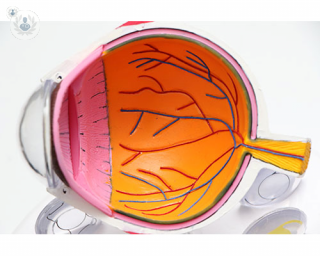

An expert insight into vitreoretinal surgery
By Mr Tafadzwa Young-Zvandasara
2025-01-28
Vitreoretinal surgery refers to surgical procedures that treat conditions affecting the retina and the vitreous, which is the gel-like substance inside the eye. In severe cases, these surgeries can be critical to prevent vision loss. Here, Mr Tafadzwa Young-Zvandasara, leading consultant ophthalmic surgeon, provides an expert insight into vitreoretinal surgery, addressing common patient questions. See more
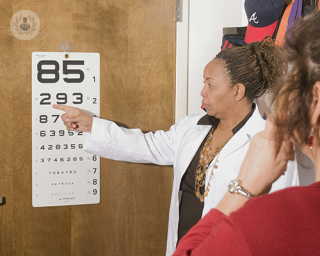

Retinal detachment: Early detection and treatment
By Mr Serafeim Antonakis
2025-01-28
Retinal detachment is a serious and vision-threatening eye condition that requires immediate medical attention. Here, Mr Serafeim Antonakis, renowned consultant ophthalmologist and vitreoretinal surgeon, provides a comprehensive overview of retinal detachment, including its signs and symptoms, causes, and treatment options. See more
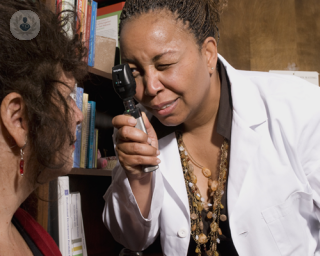

Treatment options for retinal detachment
By Mr Sami Habal
2025-01-28
Retinal detachment is a serious eye condition where the retina, a thin layer of tissue at the back of the eye, separates from its normal position. The treatment approach for retinal detachment depends on the severity and type of detachment. See more


Age-related macular degeneration (AMD): Your questions answered
By Mrs Samantha Mann
2025-01-28
Age-related macular degeneration (AMD) is a common eye disease among people over the age of 50 that affects central vision, causing distorted, blurred or reduced vision. Here, Mrs Samantha Mann, renowned consultant ophthalmologist, provides an expert insight into AMD. See more
Experts in Retina
-
Mr Niaz Islam
OphthalmologyExpert in:
- Cataracts
- Chalazion
- Diabetic retinopathy
- Macular degeneration (AMD)
- Retina
- Watery eyes
-
Mr Praveen Patel
OphthalmologyExpert in:
- Macular degeneration (AMD)
- Retina
- Retinal vein occlusion
- Diabetic retinopathy
- Macular oedema
- Intravitreal injection
-
Professor Adnan Tufail
OphthalmologyExpert in:
- Retina
- Macular degeneration (AMD)
- Diabetic retinopathy
- Cataracts
- Myopia
- Retinal vein occlusion
-
Mr Roger Wong
OphthalmologyExpert in:
- Retina
- Diabetic retinopathy
- Retinal detachment
- Macular hole
- Epiretinal membrane
- Macular degeneration (AMD)
-
Mr Ulrich Meyer-Bothling
OphthalmologyExpert in:
- Cataracts
- Lens replacement (intraocular lenses)
- Glaucoma
- Retina
- Diabetic retinopathy
- YAG laser capsulotomy
- See all

Great Ormond Street Hospital
Great Ormond Street Hospital
Great Ormond Street. WC1N 3JH
No existe teléfono en el centro.
By using the telephone number provided by TOP DOCTORS, you automatically agree to let us use your phone number for statistical and commercial purposes. For further information, read our Privacy Policy
Top Doctors

The Runnymede Hospital - part of Circle Health Group
The Runnymede Hospital - part of Circle Health Group
Guildford Street, Ottershaw, Lyne, Chertsey KT16 0RQ
No existe teléfono en el centro.
By using the telephone number provided by TOP DOCTORS, you automatically agree to let us use your phone number for statistical and commercial purposes. For further information, read our Privacy Policy
Top Doctors

Laser Vision
Laser Vision
Prema Compass Road North Harbour Business Park Portsmouth PO6 4RP
No existe teléfono en el centro.
By using the telephone number provided by TOP DOCTORS, you automatically agree to let us use your phone number for statistical and commercial purposes. For further information, read our Privacy Policy
Top Doctors
-
Great Ormond Street Hospital
Great Ormond Street. WC1N 3JH, Central LondonExpert in:
- Cancer
- Paediatric neurosurgery
- Paediatrics
-
The Runnymede Hospital - part of Circle Health Group
Guildford Street, Ottershaw, Lyne, Chertsey KT16 0RQ, ChertseyExpert in:
- Cardiology
- Hand surgery
- General Surgery
- Maxillofacial Surgery
- Oral surgery
- Orthopaedic surgery
-
Laser Vision
Prema Compass Road North Harbour Business Park Portsmouth PO6 4RP, HavantExpert in:
- Cataracts
- Laser eye surgery
- ICL lens implants
- Ophthalmology
- Keratoconus
- Lens replacement
- See all
- Most viewed diseases, medical tests, and treatments
- Visual impairment
- Diabetic retinopathy
- Visual stress (Meares-Irlen syndrome)
- Presbyopia
- Nystagmus
- Myopia
- Hyperopia (farsightedness)
- Eye examination
- Demodex
- Blepharitis








